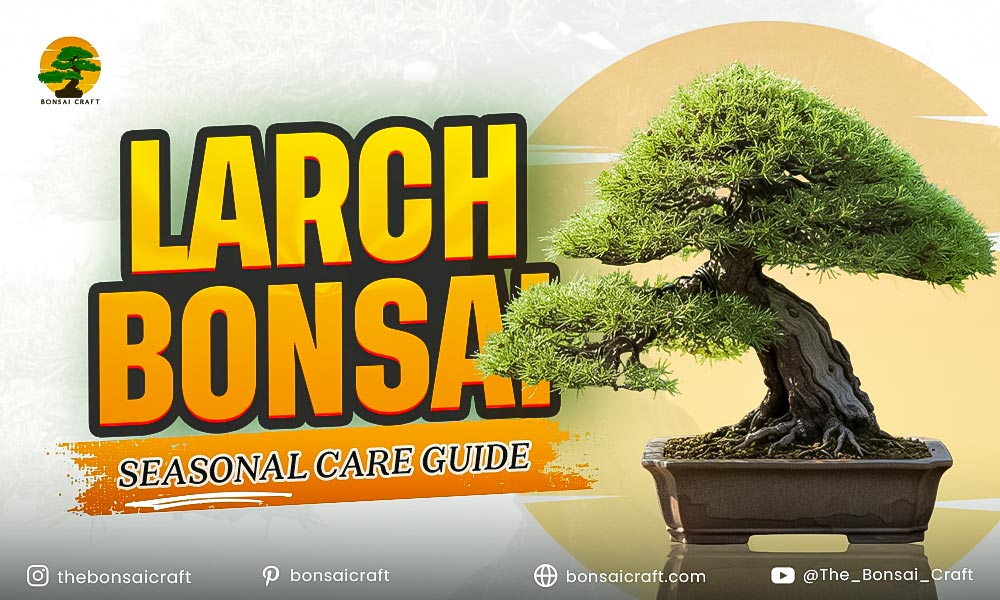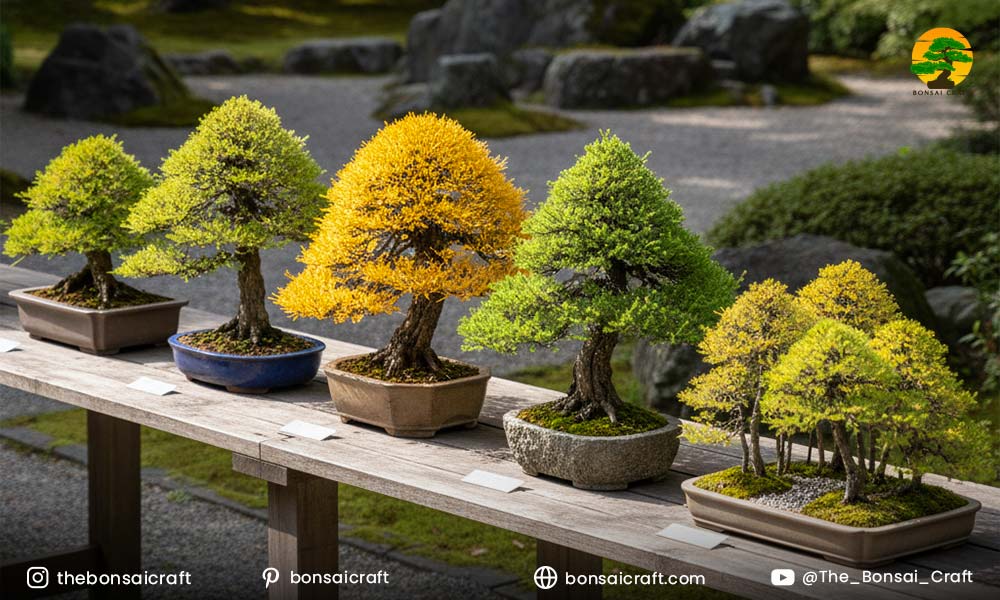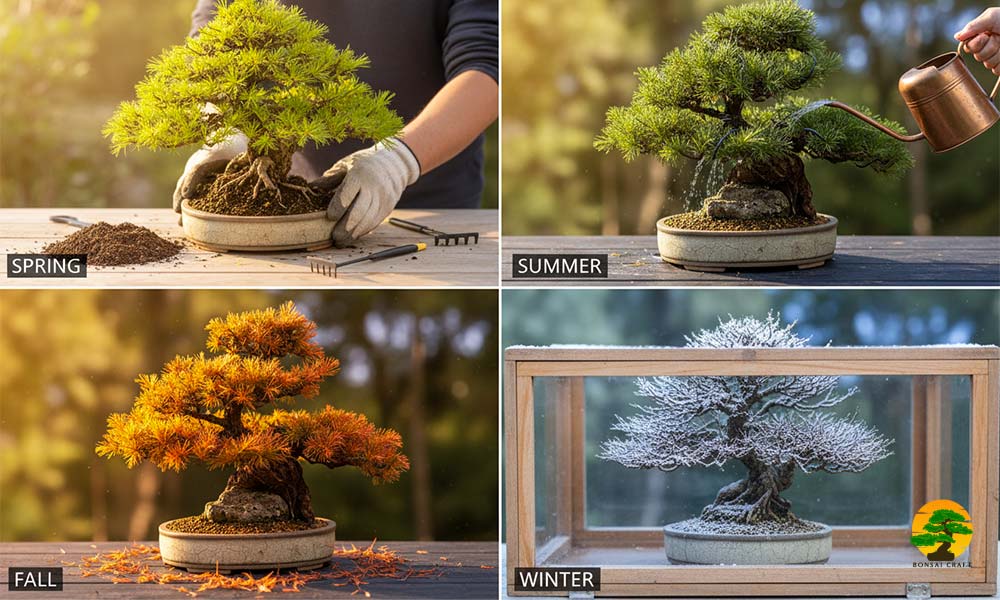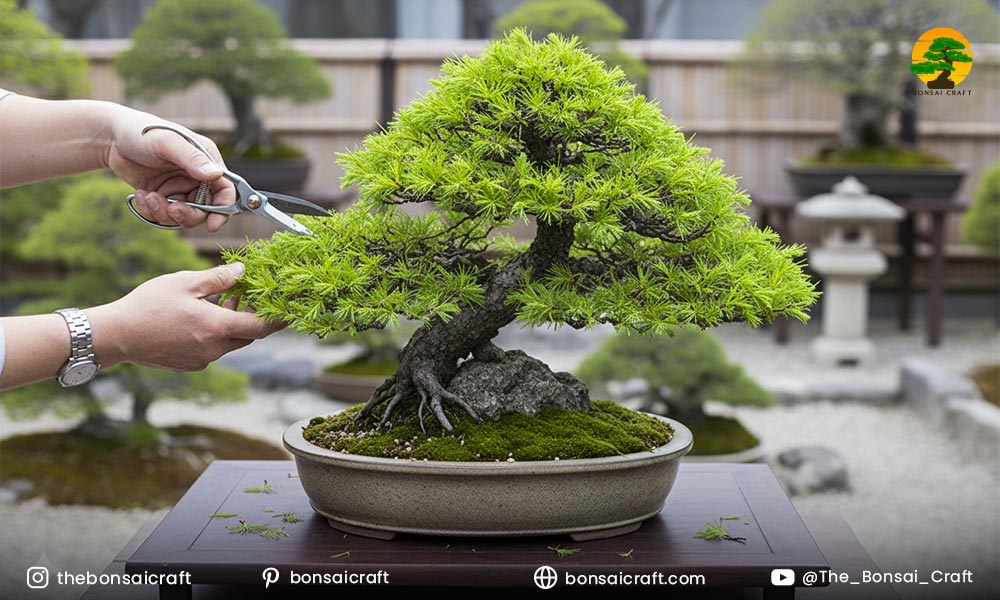
Bonsai cultivation is a meditative and artistic practice that requires dedication, patience, and a solid understanding of plant care. One of the most unique and rewarding species for bonsai is the larch bonsai tree. Known for its delicate, needle-like leaves that change colors in the fall, the larch bonsai offers a beautiful and ever-changing focal point for bonsai enthusiasts.
Whether you are cultivating an American larch bonsai, Japanese larch bonsai, or a golden larch bonsai, each variety brings something special to the bonsai world. Larches are deciduous conifers, meaning they shed their needles in winter, giving them a distinctive seasonal cycle that can challenge even seasoned bonsai growers. Understanding how to care for your larch bonsai tree throughout the year is crucial for its longevity and aesthetic appeal.
In this comprehensive larch bonsai care guide, I’ll cover everything you need to know about styling larch bonsai, pruning larch bonsai, repotting larch bonsai, and how to adapt care for the changing seasons. This guide is backed by years of bonsai cultivation experience and provides trustworthy advice to help you grow a stunning, healthy bonsai larch tree.
Why Larch Bonsai Trees Are Special
The larch bonsai is a unique species for bonsai cultivation due to its deciduous nature. Unlike most conifers, which are evergreen, larch trees shed their needles every fall, providing a striking seasonal change. The vibrant yellow or golden hues that emerge in autumn make the golden larch bonsai particularly popular. However, this seasonal shedding also presents challenges in care, especially when it comes to pruning larch bonsai and understanding the tree’s dormancy cycle.
Whether you’re growing a European larch bonsai, an American larch bonsai, or a larch forest bonsai, understanding the seasonal needs of your tree is essential for maintaining its health and beauty. By following this seasonal care guide, you’ll learn the best practices for each season, from repotting larch bonsai to pruning larch bonsai and ensuring your tree thrives through its active and dormant phases.

Larch Bonsai Overview: Types and Features
There are several types of larch trees commonly grown as bonsai. Each variety has unique characteristics, but all share the need for specific care during each season.
American Larch Bonsai
The American larch bonsai (Larix laricina) is native to North America and features a light green color in the spring and summer, with stunning golden yellow foliage in the fall. This variety is known for its fast growth, making it a great choice for those looking to shape their bonsai quickly.
Japanese Larch Bonsai
The Japanese larch bonsai (Larix kaempferi) is prized for its ability to create elegant, upright bonsai with delicate needle clusters. This variety has a slightly slower growth rate compared to its American counterpart but offers excellent branching and beautiful fall color.
Golden Larch Bonsai
The golden larch bonsai (Larix decidua), sometimes known as the European larch bonsai, turns brilliant golden yellow in the fall, making it a standout choice for collectors who want vibrant seasonal change.
Western Larch Bonsai
The Western larch bonsai (Larix occidentalis) is native to the western United States and offers a rugged appearance with dense clusters of soft, needle-like leaves. This variety is well-suited for those who prefer a more naturalistic style.
Larch Bonsai Forest
Creating a larch bonsai forest involves planting multiple larch trees together in a pot to mimic a natural forest landscape. This style is perfect for creating a dynamic and layered bonsai display.

Larch Bonsai Seasonal Care
Caring for your larch bonsai tree requires adapting your care routine to the changing seasons. Larch trees go through distinct phases throughout the year, from active growth in the spring and summer to dormancy in the winter. Here’s a breakdown of how to care for your bonsai larch tree in each season.
Spring: Rejuvenation and Growth
Spring is the season when your larch bonsai begins to emerge from dormancy. This is the time when new growth starts, and you can begin shaping your tree.
- Repotting Larch Bonsai: Early spring is the ideal time to repot larch bonsai before the new buds begin to open. This allows the tree to establish itself in fresh soil and encourages healthy root development.
How to Repot Larch Bonsai:- Carefully remove the tree from its pot.
- Trim any excessively long or circling roots.
- Place the tree in a new pot with well-draining bonsai soil.
- Water thoroughly after repotting.
- Pruning Larch Bonsai: Spring is also a good time to prune your larch bonsai to remove dead or damaged branches and to encourage the development of new shoots. Be cautious with heavy pruning, as larch bonsai trees are sensitive to cuts. Focus on removing any dead or unwanted growth and shaping the tree.
- Fertilization: As your larch bonsai tree begins to grow, start fertilizing with a balanced, slow-release fertilizer. This will provide the necessary nutrients for strong, healthy growth.
Summer: Active Growth and Shaping
Summer is the peak growing season for larch bonsai trees. During this time, you’ll want to focus on maintaining the shape of your tree and supporting its growth.
- Watering: Larch bonsai trees prefer consistently moist soil during the growing season, so make sure to water regularly. However, ensure that the pot has proper drainage to prevent root rot.
- Pruning and Styling Larch Bonsai: Summer is an excellent time to continue shaping your bonsai larch tree. You can wire the branches to guide them into the desired shape, but avoid wiring too tightly to prevent damage to the bark. Styling larch bonsai often involves keeping the tree’s structure open to allow light to reach the inner branches.
- Pest Management: Keep an eye on your larch bonsai for signs of pests, such as aphids or spider mites. Use organic pest control methods, such as neem oil, to address any infestations.
Fall: Preparation for Dormancy and Color Change
As the temperatures cool in fall, larch bonsai trees prepare to shed their needles and enter dormancy. This is the time to enjoy the beautiful color changes in your tree before it rests for the winter.
- Pruning and Wiring: Fall is a good time to stop pruning and wiring as the tree slows down its growth. Avoid heavy pruning at this time, as it can stress the tree as it prepares for dormancy.
- Watering: Reduce watering as the larch bonsai tree begins to enter dormancy. Water the tree when the soil feels dry, but avoid overwatering, which could lead to root rot.
Winter: Dormancy and Care
Your larch bonsai is planted during winter, when the tree is still and rests. During this stage, the tree is expected to release its leaves as a means to gather energy, and the trunk is equally hollowed and gains limbs. This then becomes the stage where the tree is lifted the most: where the most care is needed.
- Temperature: Like other trees, Larch bonsai trees are hardy, but if you are growing your tree indoors, be sure to maintain the indoor temperature at a cool level. Do not let your bonsai trees outdoors in freezing temperatures. It is suggested that you keep the tree inside a cold frame or some other sheltered area during the coldest winters.
- Watering: Try to maintain a slower rate of watering during the cold winter. Larch bonsai trees during dormancy don’t require a lot of water. So try to monitor the soil so that it only gets watered when needed.
- No Pruning: Do not prune during the winter. The tree is resting and will not respond to prunes in the winter.
Styling Your Larch Bonsai Tree
Styling a larch bonsai tree involves using wiring, pruning, and shaping techniques to create the desired look. There are several popular styles for larch bonsai, including:
- Formal Upright (Chokkan): This style is perfect for the Western larch bonsai, where the tree grows straight and tall, with branches arranged in an orderly manner.
- Informal Upright (Moyogi): Golden larch bonsai often looks great in this style, with gently curving trunks and branches that create a more natural, flowing appearance.
- Broom Style (Hokidachi): This style works well for creating a dense canopy of foliage. It’s perfect for the European larch bonsai or Japanese larch bonsai.
- Cascade Style (Kengai): The cascading effect is ideal for a larch bonsai forest, where trees grow naturally in varying directions.

Pruning Larch Bonsai Trees: Best Practices
Pruning your larch bonsai tree is essential for maintaining its shape and encouraging healthy growth. Here are some key points to remember when pruning larch bonsai:
- When to Prune Larch Bonsai: Prune your larch bonsai during the active growing season (spring and early summer). Avoid heavy pruning in the fall or winter, as this can stress the tree.
- How to Prune Larch Bonsai: Focus on removing dead or damaged branches and any new growth that disrupts the desired shape. Light pruning helps maintain the tree’s structure and encourages new branching.
- Use Sharp Tools: Always use sharp, clean tools when pruning to make clean cuts and prevent infections.
Conclusion: Enjoying Your Larch Bonsai Tree
Caring for a larch bonsai tree requires understanding the tree’s seasonal cycle and adapting your care routine accordingly. By following this seasonal care guide and incorporating techniques like repotting, pruning, and styling, you’ll ensure that your larch bonsai remains healthy and beautiful year after year.
Expert Tip: Always remain patient with larch bonsai due to the long wait associated with growing them. Their deciduous nature makes fall and winter attention a must, but every other season, these larch bonsai will reward you with breathtaking views that make the hassle completely worth it.
FAQs About Larch Bonsai
When is the best time to repot a larch bonsai?
A larch bonsai can best be repotted in spring, before new growth. This is to ensure that the tree is able to settle in the new soil before the growing season.
How do I prune a larch bonsai?
To shape larch bonsai, it is important to get rid of dead and thin branches and to avoid excessive growth. Larch bonsai are best pruned in the growing season to avoid stress.
Can I grow a larch bonsai indoors?
Although larch bonsai are designed to be grown outside, they can tolerate the indoors in winter if the temperatures are low and there is sufficient lighting.
When should I stop pruning my larch bonsai?
Don’t prune larch bonsai after late summer or early autumn; otherwise, there would be no time left for the trees to prepare for the Larch dormancy period..
How often should I water my larch bonsai tree?
You must water your larch bonsai regularly but the soil should be wet, not soggy. Make very few cutbacks to watering in winter when the tree enters dormancy.
